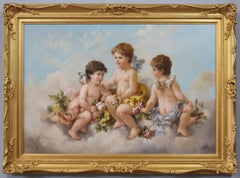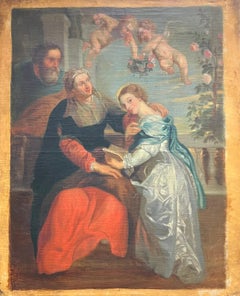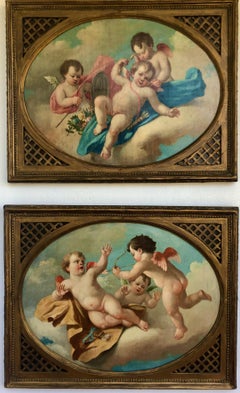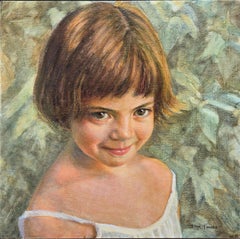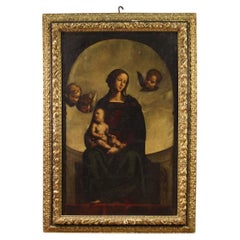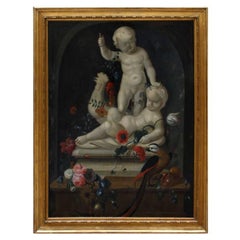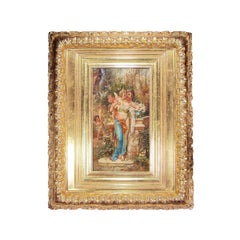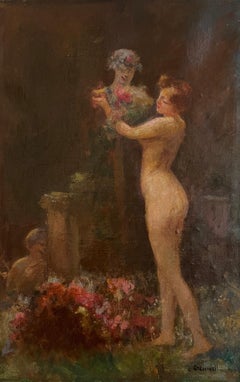Oil Paintings With Cherubs
to
5
21
13
16
11
11
6
4
3
2
1
1
1
1
1
1
1
1
1
1
1
1
1
1
1
1
1
Sort By
19th Century genre oil painting of cherubs with flowers
By Charles Augustus Henry Lutyens
Located in Nr Broadway, Worcestershire
Charles Augustus Henry Lutyens
British, (1829-1915)
Cherubs with Flower Garlands
Oil on canvas
Category
19th Century Victorian Figurative Paintings
Materials
Canvas, Oil
$5,206
H 25.5 in W 35.25 in D 3 in
Family Devotion with Cherubs 18th Century Old Master Oil Painting after Rubens
Located in Cirencester, Gloucestershire
Family Devotion with Cherubs
French School, 18th century
after the earlier work by Sir Peter Paul
Category
18th Century Old Masters Figurative Paintings
Materials
Oil
Pair of Antique French Paintings With Cherubs
By (After) Francois Boucher
Located in Lake Worth Beach, FL
Pair of Antique Paintings With Cherubs
After Francois Boucher (1703-1770)
Boucher is known for
Category
Late 18th Century Baroque Figurative Paintings
Materials
Cotton Canvas, Oil
"Portrait of Maria" Oil Painting Young Girl with Cherubic Smile Big Eyes Green
By Borja Fernandez
Located in Austin, TX
Oil on Cradled Birch Panel
Panel Size: 16 x 16 in.
Framed Size: 18 x 18 in.
A lively and luminous
Category
Early 2000s American Realist Portrait Paintings
Materials
Oil, Wood Panel
17th Century Oil on Canvas Altarpiece Painting Madonna with Child and Cherubs
Located in Vicoforte, Piedmont
A magnificent altarpiece from the second half of the 17th century. Painting oil on canvas depicts a
Category
Antique 1670s Italian Paintings
Materials
Canvas
$30,295
H 69.69 in W 48.43 in D 3.15 in
Des Enfants Traînant Un Chariot Chargé de Fruits
Located in Milford, NH
A fine oil painting with cherubs and a cart of fruit by French artist Leger Cherelle (1816-1867
Category
1830s Old Masters Figurative Paintings
Materials
Oil, Board
18th Century Parrot with Cherubs and Flowers Painting Oil on Canvas by Reneman
Located in Milan, IT
flowers
Oil on canvas, 100.5 x 84.5 cm
Signed on the base “I. Reneman fecit "
The painting
Category
Antique 18th Century Dutch Paintings
Materials
Canvas
$5,126
H 39.57 in W 33.27 in D 1.58 in
Hans Zatzka, Austrian Oil on Canvas Titled "Spring Love" Maiden with Cherubs
By Hans Zatzka
Located in LA, CA
Hans Zatzka (Austrian, 1859-1945) a superb quality oil on canvas titled "Spring Love" depicting a
Category
19th Century Romantic Figurative Paintings
Materials
Oil
Hans ZatzkaHans Zatzka, Austrian Oil on Canvas Titled "Spring Love" Maiden with Cherubs, Circa: 1885
$99,600 Sale Price
20% Off
H 42.5 in W 34.25 in D 5 in
Nymph from behind with statue and cherub
By Albert Cresswell
Located in Genève, GE
Work on canvas
Category
20th Century Nude Paintings
Materials
Oil
A Cherub with a Future Prime Minister Inside
Located in San Francisco, CA
portrait that combines the cherubic shape of a little angel with the determination of a future prime
Category
20th Century Modern Portrait Paintings
Materials
Canvas, Oil
Hans Zatzka, Austrian Oil on Canvas Titled "Spring Love" Maiden with Cherubs"
By Hans Zatzka
Located in Los Angeles, CA
Hans Zatzka (Austrian, 1859-1945) a superb quality oil on canvas titled "Spring Love" depicting a
Category
Antique 1880s Austrian Belle Époque Paintings
Materials
Wood, Giltwood
$99,600 Sale Price
26% Off
H 42.5 in W 34.25 in D 5 in
A Lady by a Lake with Swans and Cherubs
By Joseph Vital Lacaze
Located in St. Albans, GB
Joseph Vital Lacaze
Oil on canvas
Canvas Size: 35 x 58" (89 x 146cm)
Outside Frame Size: 39 x 59
Category
Early 20th Century Post-Impressionist Landscape Paintings
Materials
Oil
Angelic Cherubs with Classical Figure in Wilderness Finely Painted Preparatory
Located in Cirencester, Gloucestershire
Figure with Cherubim in Wilderness
Italian School, 17th century
oil painting on wood panel
framed
Category
17th Century Old Masters Figurative Paintings
Materials
Oil, Wood Panel
$3,516
H 13 in W 11 in D 1 in
Penitent Saint in Wilderness with Angels & Cherubs Italian Old Master on Copper
Located in Cirencester, Gloucestershire
The Penitent Saint
Italian artist, 17th century
oil on copper panel, framed
framed: 10 x 8 inches
Category
17th Century Old Masters Figurative Paintings
Materials
Oil
Vulcan with Cherubs Painting 18th Century
Located in Milan, IT
Oil painting on canvas. The mythological scene depicts the god mask maker Vulcan. He is depicted
Category
18th Century Figurative Paintings
Materials
Oil
Allegoric Painting Cherubs Playing with Cards Oil on Canvas 18th Century
Located in Milan, IT
Oil on canvas. The depicted scene is set in a closed environment with a wide window which provides
Category
18th Century Figurative Paintings
Materials
Oil
$3,146
H 36.62 in W 47.64 in D 1.19 in
Vintage Oil Painting on Wood with a Winged Cherub
Located in Toledo, OH
Vintage oil painting on wood with a winged cherub with crossed arms. Carved wood and Gesso arched
Category
20th Century Paintings
Materials
Wood
Allegory with Cherubs Oil on Canvas 18th Century
Located in Milan, IT
Oil on canvas. In the scene, probably an allegory of agriculture, a cherub is taking a bundle of
Category
18th Century Interior Paintings
Materials
Oil
Allegory with Cherubs Oil on Canvas 18th Century
Located in Milan, IT
Oil on canvas. The scene depicts two cherubs, one of them is picking some fruit from the ground and
Category
18th Century Other Art Style Figurative Paintings
Materials
Oil
18th Century Oil on Canvas Italian Antique Painting Allegory with Cherubs, 1730
Located in Vicoforte, Piedmont
Antique Italian painting from the first half of the 18th century. Artwork oil on canvas, first
Category
Antique Mid-18th Century Italian Paintings
Materials
Canvas
$7,923
H 52.76 in W 49.22 in D 3.94 in
19th Century French Oil on Canvas Allegoric Blue and White Painting with Cherub
Located in Firenze, IT
graceful cherub seems to twirl over her.
This oil on canvas painting represents the allegory of music
Category
Antique 19th Century French Rococo Paintings
Materials
Canvas, Wood
$3,495
H 34.26 in W 34.26 in D 1.58 in
Cherubs with Scrolls -Oil on Canvas after Angelica Kaufman
Located in Houston, TX
oil on canvas
of cherubs at work with scrolls
A 19 th c. Painting in good condition
Well framed
Category
Antique Late 19th Century Austrian Paintings
19th century oil on canvas. Cherub with floral wreath
Located in San Francisco, CA
19th century oil on canvas. Cherub with floral wreath
Craquelure is noticeable
The condition is
Category
Antique 19th Century Paintings
Materials
Canvas
19th Century French Louis XV Style Antique Pier Mirror with Cherub Oil Painting
Located in Shippensburg, PA
.
This charming work is signed in the lower left "M. Heim" and depicts a pair of cherubs tugging a vine
Category
Antique 19th Century French Louis XV Pier Mirrors and Console Mirrors
Materials
Glass, Giltwood, Paint
$3,100
H 67.13 in W 34 in D 2 in
Italian Neoclassical Style Oil on Board
Located in Cypress, CA
Highly decorative Italian neoclassical style oil on board painting with cherubs and swags decorated
Category
20th Century Italian Neoclassical Paintings
Materials
Wood
18th century painted and gilded Trumeau Mirror
Located in New Orleans, LA
Painted and gilded trumeau with oil painting depicting a cherub with a lamb
Category
Antique 18th Century and Earlier French Trumeau Mirrors
Bacchus with Cherubs Oil Painting Anonymous Artist 17th Century
Located in Milan, IT
Oil painting on canvas. Already attributed to Giovanni Benedetto Castiglione (1609-1664) called "il
Category
17th Century Landscape Paintings
Materials
Oil
$2,610
H 25.2 in W 30.32 in D 1.58 in
Antique Italian Oil Painting Procession of Putti Cherubs Playfully with Flowers
Located in Cirencester, Gloucestershire
Italian School, 19th century
oil on canvas, framed
framed: 14 x 22 inches
canvas: 8 x 15 inches
Category
19th Century Old Masters Figurative Paintings
Materials
Oil
Antique Rococo-Inspired Floral Oil with Ornamental Cherub Scrollwork
Located in Cirencester, Gloucestershire
Antique Rococo-Inspired Floral
oil on thin canvas paper, stuck in yellow paper
painting: 10 x
Category
Early 19th Century Rococo Still-life Paintings
Materials
Oil
Dutch Shool, Vanitas Scene with Cherub Leaning on a Skull, Oil on Canvas
Located in Leuven , BE
Cherub where, as in the present work, the naked child is combined with a vanitas still life.
Category
Antique 18th Century Dutch Paintings
Materials
Canvas
$2,404
H 30.71 in W 27.96 in D 2.76 in
FINE EARLY 1700'S ITALIAN BAROQUE OLD MASTER - MARY MAGDALENE WITH CHERUBS
Located in Cirencester, Gloucestershire
Medium: oil painting on canvas laid on board, framed
Size: painting: 34cm x 49cm
Provenance
Category
Early 18th Century Baroque Figurative Paintings
Materials
Oil
Italian BaroqueFINE EARLY 1700'S ITALIAN BAROQUE OLD MASTER - MARY MAGDALENE WITH CHERUBS, c. 1700's
$1,124
H 14 in W 21 in D 1 in
18th C, Late Baroque Style, Still Life, Dutch School, Vanitas Scene with Cherub
Located in brussel, BE
earthly for the heavenly, is typical of a memento mori painting. The skull immediately confronts us with
Category
18th Century Baroque Figurative Paintings
Materials
Oil
$3,006
H 30.52 in W 27.96 in D 2.76 in
19th Century French Oil on Board Painting with Cherubs Signed H. Borneau
By Henri Borneau
Located in Dallas, TX
This fine oil on board was painted in France circa 1870. The composition is signed on the lower
Category
Late 19th Century Figurative Paintings
Materials
Oil, Board
$2,600
H 20 in W 50 in D 1 in
Pair of French Cherubs Oil Wall Painting, 1929
Located in Roubaix, FR
French Master House pair of wall oil painting on canvas with large cherubs signed H Dechen 1929
Category
Vintage 1920s French Art Nouveau Paintings
Materials
Canvas, Paint
Get Updated with New Arrivals
Save "Oil Paintings With Cherubs", and we’ll notify you when there are new listings in this category.
Oil Paintings With Cherubs For Sale on 1stDibs
Find a variety of oil paintings with cherubs available on 1stDibs. Finding the perfect examples of these works for your space is difficult — today, we have a vast range of variations and more on offer. These items have long been popular, with older editions for sale from the 18th Century and newer versions made as recently as the 19th Century. If you’re looking to add an oil paintings with cherubs that pops against an otherwise neutral space in your home, the works available on 1stDibs include that feature elements of brown, black and more. Each of these unique pieces was handmade with extraordinary care, with artists most often working in oil paint, paint and canvas.
How Much are Oil Paintings With Cherubs?
Oil paintings with cherubs can differ in price owing to various characteristics — the average selling price for items in our inventory is $4,306, while the lowest priced sells for $2,751 and the highest can go for as much as $145,000.
Questions About Oil Paintings With Cherubs
- 1stDibs ExpertFebruary 13, 2024To identify an oil painting, look closely at its surface. Compared to other paintings, pieces produced in oils usually show off a variety of textures across the canvas, and the paint will appear layered on. If you're looking to determine the name, age or creator of a work, try snapping a photo with your smartphone’s camera and conducting a reverse image search online. Shop a diverse assortment of oil paintings on 1stDibs.
- 1stDibs ExpertMay 3, 2024Jan van Eyck is widely considered by art historians to be the father of oil painting. While the usage of oil paints dates back to 7th-century China, the Flemish painter popularized the material, using oils to produce highly detailed works such as The Arnolfini Portrait. The Northern Renaissance master also influenced many other artists, such as Hugo van der Goes and Gerard David. Shop an assortment of fine art on 1stDibs.
- When was oil paint invented?1 Answer1stDibs ExpertFebruary 27, 2024Oil paint was invented during the 7th century A.D. The earliest examples of oil paintings have been traced to Afghanistan and depict scenes related to the Buddhist religion. Records dating back to the 12th century indicate that early Christian monks in Europe used oil paints to decorate furniture, and a century later, some artists began finishing tempera paintings with touches of oil paint. It wasn't until the 15th century that oil paints became a common medium for European painters, when Flemish artists like Jan van Eyck began favoring them over tempera. Explore a variety of oil paintings on 1stDibs.
- What is abstract oil painting?1 AnswerLilac Gallery Ltd.March 17, 2021An abstract oil painting and an artwork that is made with oil paint on a medium like canvas, wood board, or other panels like canvas board. And the 'abstract' term refers to the Movement & Style of the piece. As abstraction indicates a departure from reality in the depiction of imagery in art, the artist creates a painting where the subject, shape, form, color, and line, is created with no particular references of the world but as a composition that may exist with a degree of independence from its vision.
- 1stDibs ExpertMarch 22, 2024To maintain oil paintings that you purchased for your home, experts suggest that you keep them out of direct sunlight. Prolonged exposure to the sunlight coming in from a window can fade the colors in your painting. Do not hang your oil painting near a heat source or where it can get wet (bathrooms and kitchens are not safe for your oil painting).
You may wish to dust your oil painting so that layers of dust don’t begin to gather on its surface. This should only be considered to remove loose dust. Never spray any chemical substance on your oil painting. Do not use a damp cloth to dust your oil painting. (Again, your painting should not be exposed to moisture.)
To remove loose dust, use a soft brush that measures approximately one to two inches wide with natural-hair bristles. Do not use a dust cloth or a feather duster, as those items may catch or leave threads or feathers behind. Do not apply pressure or dust your painting for an extended period of time.
If you think that your oil painting is considerably dirty or believe that other issues may be at work, experts strongly suggest that you consult with a professional conservator.
Read about how to arrange your wall art and find oil paintings for sale on 1stDibs. - Can you use oil paint on wood?1 Answer1stDibs ExpertFebruary 22, 2021You can use oil paint on wood as long as you prep the wood first. The first thing you should do is seal the wood with a primer. Ideally, paint two coats of sealer onto the wood so that the paint doesn't cause the wood to rot over time.
- 1stDibs ExpertAugust 15, 2024To tell how old an oil painting is, research the artist who produced it. You can use the mobile app Smartify to snap a photo of the signature on your painting and identify the artist. Read biographical information about the artist online and look at images of their work to estimate the age of your piece. Alternatively, you can get the opinion of a knowledgeable art dealer or certified appraiser. Explore a wide variety of oil paintings on 1stDibs.
- Did Dali use oil paint?1 Answer1stDibs ExpertApril 5, 2022Yes, Dali did indeed use oil paint. Although he used oil paints in the traditional method, he would at times add natural resin or linseed oil to play with fluidity and texture. You can shop a selection of Salvador Dali’s pieces from some of the world’s top art dealers on 1stDibs.
- 1stDibs ExpertApril 5, 2022The largest oil painting in the world is in the main hall of the Doge's Palace located in Venice, Italy. Its name is Il Paradiso. Tintoretto painted it around 1592, and it measures 22 meters by 7 meters. Shop a large collection of oil paintings on 1stDibs.
- 1stDibs ExpertSeptember 25, 2019
Varnishing an oil is not necessary, but it is recommended because it protects the painting and corrects surface irregularities.
- 1stDibs ExpertMay 3, 2024A few things make an oil painting valuable. Age has a major impact on price, with pieces made over a century ago tending to fetch the highest prices. Who created the painting also matters. The more famous the artist, the higher the selling price for a painting is likely to be. Finally, the condition of the work and whether it is in its original frame will also impact how much it is worth. Find a diverse assortment of oil paintings on 1stDibs.
- 1stDibs ExpertAugust 20, 2024The difference between a lithograph and an oil painting comes down to uniqueness and technique. To produce an oil painting, an artist applies oil-based paints to a canvas or another surface using a brush. The process results in a single work of art. Lithography is a form of printmaking that begins by drawing on or painting on a stone surface with an oil-based substance, such as a greasy crayon or tusche, an oily wash. The stone is then covered with water, which is repelled by the oily areas. Oil-based ink is then applied to the wet stone, adhering only to the oily image. Through lithography, an artist can produce dozens, or even thousands, of copies of a single image. On 1stDibs, shop a large selection of lithographs and oil paintings.
- 1stDibs ExpertMarch 22, 2024Yes, sunlight affects oil paintings. Keep your oil paintings away from direct sunlight.
To maintain oil paintings that you purchased for your home, experts suggest that you keep them out of sunlight. Prolonged exposure to the sunlight coming in from a window can fade the colors in your painting. Do not hang your oil painting near a heat source or where it can get wet (bathrooms and kitchens are not safe for your oil painting).
You may wish to dust your oil painting so that layers of dust don’t begin to gather on its surface. This should only be considered to remove loose dust. Never spray any chemical substance on your oil painting. Do not use a damp cloth to dust your oil painting. (Again, your painting should not be exposed to moisture.)
To remove loose dust, use a soft brush that measures approximately one to two inches wide with natural-hair bristles. Do not use a dust cloth or a feather duster, as those items may catch or leave threads or feathers behind. Do not apply pressure or dust your painting for an extended period of time.
If you think that your oil painting is considerably dirty or believe that other issues may be at work, experts strongly suggest that you consult with a professional conservator.
Read about how to arrange your wall art and find oil paintings for sale on 1stDibs. - 1stDibs ExpertApril 5, 2022To tell if your oil painting is authentic, first check the signature of the artist to start your research. Use a magnifying glass to check the texture of the painting, and finally check the back for the painting’s original stretchers. Shop a selection of expertly vetted artwork from some of the world’s top art dealers on 1stDibs.
- 1stDibs ExpertFebruary 13, 2023Because the value of an oil painting can vary greatly based on the artist, the subject and the condition of the piece, it's generally best to work with a certified appraiser. A knowledgeable professional can evaluate the piece and estimate its value. Shop a variety of authentic oil paintings from some of the world’s top galleries on 1stDibs.
- La ChrysomeleFebruary 24, 2021Any artwork is worth and only worth the price someone is willing to pay for it (unfortunately, whether one can afford it or not is another story). Different people may have different reasons to attribute value to an artwork, from the purest (falling in love with it) to what is often considered as the most vile (speculation), going through remembrance, pride of ownership, or brag, among other reasons. For most living artists, the price of the artworks is usually set by the artist and/or the gallery which represent him or her, by type and size of artwork, and corresponds to an equilibrium price between the rate at which artworks are sold and the rate at which new artworks are produced by the artist. For artworks from dead artists sold by professional dealers, the price is often based on auctions results for similar pieces of the same artists. Oil paintings are usually pricier than other techniques because it is considered more difficult to master, but also because oil paintings are known for their ability to last centuries.
- How much do oil paintings cost?1 Answer1stDibs ExpertSeptember 25, 2019
On 1stdibs, oil paintings cost between $60 and $6,200,000.
- 1stDibs ExpertApril 5, 2022The best place to find oil paintings and discover new artists is at local art galleries. There are also many online art dealers who provide information about artists and sell their works. On 1stDibs, you’ll discover a variety of art styles from master oil painters.
- 1stDibs ExpertApril 5, 2022To find the artist of an oil painting, look on the back of the canvas. Sometimes, you will find the artist’s name and the year of production on the back. If the canvas is in a frame, gently peel away the paper covering the back to access the canvas. In the event you cannot find any identifying information, seek the help of a licensed art appraiser. Shop a selection of oil paintings on 1stDibs.
- 1stDibs ExpertMarch 22, 2024Yes, oil paintings darken over time. As oil paint is made of pigment particles, the range of substances that are used as pigment in oil paint can render certain colors susceptible to aging. Slowing the aging process for an oil painting involves storing your painting properly and keeping the work out of exposed sunlight. Temperature control and humidity are also important in preserving the life of an oil painting and slowing the aging process.
To maintain oil paintings that you purchased for your home, experts suggest that you keep them out of direct sunlight. Prolonged exposure to the sunlight coming in from a window can fade the colors in your painting. Do not hang your oil painting near a heat source or where it can get wet (bathrooms and kitchens are not safe for your oil painting).
You may wish to dust your oil painting so that layers of dust don’t begin to gather on its surface. This should only be considered to remove loose dust. Never spray any chemical substance on your oil painting. Do not use a damp cloth to dust your oil painting. (Again, your painting should not be exposed to moisture.)
To remove loose dust, use a soft brush that measures approximately one to two inches wide with natural-hair bristles. Do not use a dust cloth or a feather duster, as those items may catch or leave threads or feathers behind. Do not apply pressure or dust your painting for an extended period of time.
If you think that your oil painting is considerably dirty or believe that other issues may be at work, experts strongly suggest that you consult with a professional conservator.
Read about how to arrange your wall art and find oil paintings for sale on 1stDibs.
More Ways To Browse
French Decor
Second Hand
Antique Wood Wall Decor
Greek Goddess
Italian Wood Angels
Wood Cherubs
1700s Furniture French
Hand Mirror With Painting
Italian Putti
Putti Carved
18th Century Cherub
18th Century Painted Antique Mirror
Antique Wooden Scale
Cherub Heads
Antique Wine Signs
Gilded Cherubs
Rococo Cherub
Baroque Cherub
